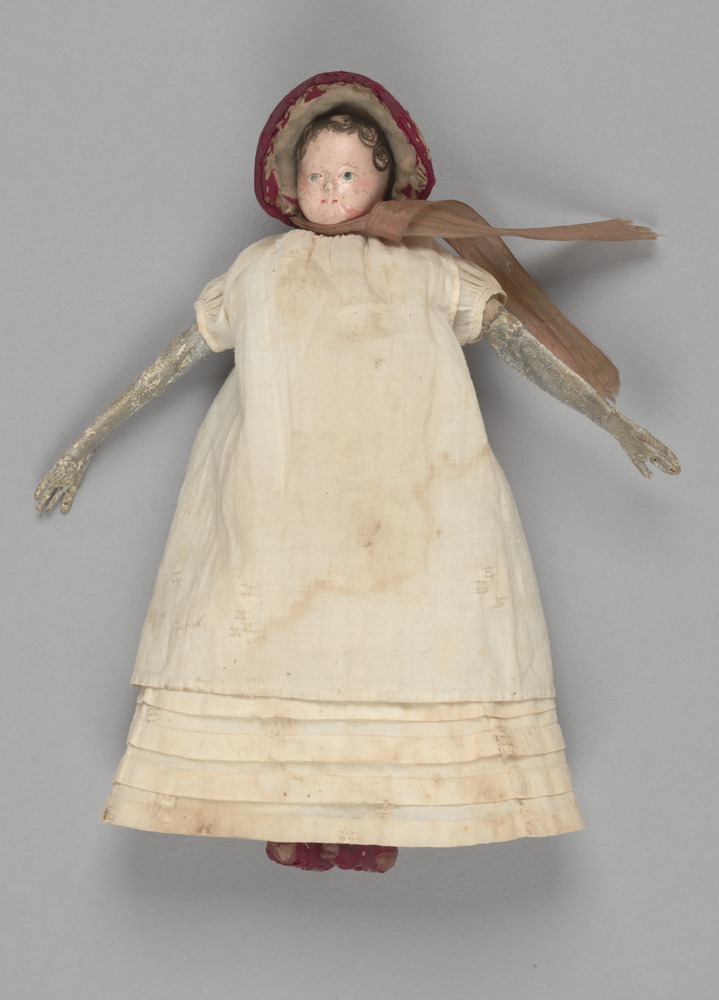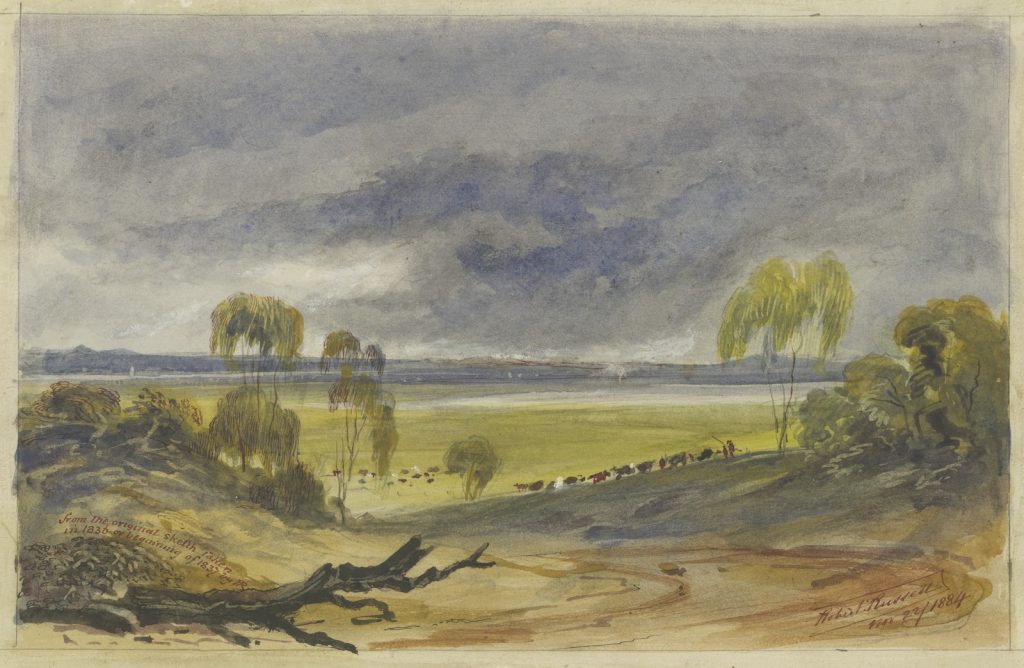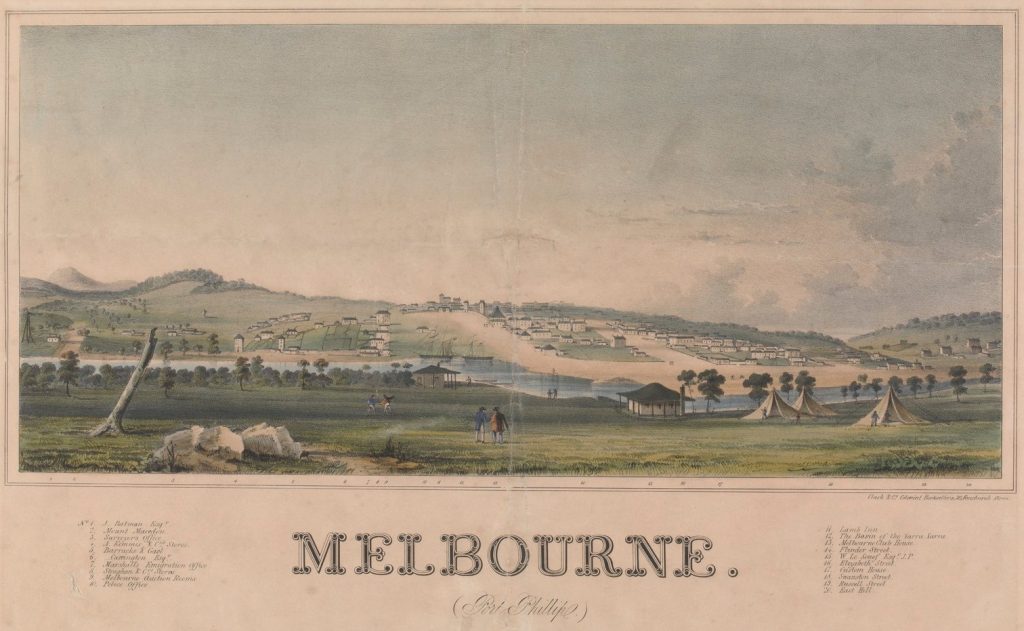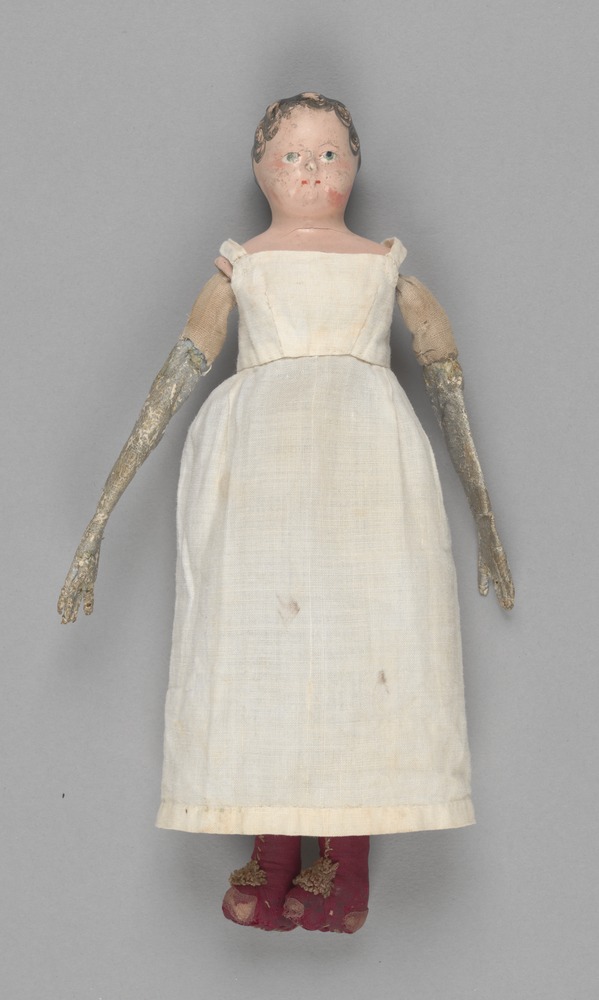The doll John Batman gave to his daughter, Elizabeth, lies preserved in a box of acid-free tissue paper. Despite the efforts of the Library’s expert conservation staff, there is something macabre about her deteriorating form – her fading facial features and her worn leather arms.

For now, Elizabeth Batman’s doll is hidden from the public eye, but if you’re lucky, you might catch her in one of her rare public appearances. Author Carmel Bird describes coming across her in one such appearance in her 1990 novel, The bluebird cafe:
She was in the glass case with a harpoon gun, a muzzle-loading revolver, a walking stick, a telescope, a holder for a clay pipe, and a silver spectacle case. Some of these things belonged to John Pascoe Fawkner and some belonged to Edward Henty. She lay like a corpse in crimson bonnet and shoes … (p 101).
Anecdotes suggest that dolls were scarce in the early days of the Port Phillip District. They either accompanied children on their sea voyage from home, or were imported from European countries such as Germany and France. Dolls were also passed down through the family. [1]

Colonial children learnt to make do with their natural surroundings for playthings, as their Indigenous counterparts had been doing for centuries. They made up their own games, and toys were often hand-crafted. There were hand-made wooden dolls, spinning tops, and hoops. Marbles and jacks were fashioned from stones and debris. [2]

Elizabeth Batman however, was luckier than most. She would have been six or seven years of age when her father, the infamous pioneer John Batman, moved his wife and seven daughters to their house on Batman’s Hill. The Batmans had thirty servants, a library, an orchard, a garden, sheep, cattle and horses, as well as a governess to educate their children.

The clothing worn by Elizabeth Batman’s doll is typical of the period. Settlers preferred cool fabrics such as muslin, silks and cotton, and often chose to wear white. [3] Hats and sun bonnets were more than just fashion accessories. They protected their wearers from the harsh Australian sun.

Jane Caverhill was the child of well-to-do pastoralists in the Western District of Victoria. Growing up in the 1840s, she recalled wearing:
… very thick lacing boots out of doors and substantial leather shoes indoors, white drawers almost to the top of our boots, white stockings, round housemaids’ skirts and very big holland pinafores with holes for the arms and falling straight down.[4]

The hairstyle of Elizabeth’s doll probably emulated her owner’s. In the 1820’s and 1830’s, European women and girls wore their hair parted in the centre with light curls around the forehead.[5] Jane Caverhill recounts how she would go to bed every night with papers in her hair to create the curling ringlets that were so fashionable at the time:
I still remember how I had to shift about my head till I could get it so that some wretched curl paper was not trying to pull up by the roots a few sensitive underneath hairs. [6]

Elizabeth Batman’s doll is an interesting relic from the earliest days of Melbourne. Her appearance is testament to the ravages of time, and how much things have changed.
References
[1] Rait, L, 1989, Through the nursery window. A history of antique and collectible dolls in Australia, 1788-1950, Oxford University Press, South Melbourne, Vic
[2] Kociumbas, J, 1997, Australian childhood. A history, Allen & Unwin, St Leonards, NSW, p 52
[3] Reade, C, 2010, ‘Resources: collections of colonial dress and fashion in Australia’. In M. Maynard (Ed.). Berg encyclopedia of world dress and fashion. Volume 7, Australia, New Zealand, and the Pacific islands, viewed 12 March 2019, <http://dx.doi.org/10.2752/BEWDF/EDch7013>
[4] Scandrett, E, 1978, Breeches & bustles : an illustrated history of clothes worn in Australia, 1788-1914, Pioneer Design Studio, Lilydale, Vic, p 20
[5] Caverhill, J, 1881, cited in MacKellar, M (ed), 2008, Strangers in a foreign land. The journal of Niel Black and other voices from the Western District, Miegunyah Press, Melbourne, Vic
[6] Ibid


Thank you for an interesting account re Elizabeth Batman’s doll. Recently went to Geelong East Cemetery for a History Alive Tour including Eliza Batman’s grave. I would like to visit State Library to see any material on Robert Hoddle my great grandfather. Can you help me to organise this. Many years ago there were 2 boxes of letters photos etc which I did not finish reviewing. Are these still available? Regards Carolyn Glembin.
Hi Carolyn, Thanks for your interest in our blog. The library has a sizeable collection of diaries, letters, papers and photographs belonging to Robert Hoddle in our Manuscripts collection. You can find them in the library catalogue. Once you have identified the items you would like to see, you can phone our Heritage staff on 8664 7009 to request them. Sarah
Love this article. Thank you.
This is lovely to see.
Many people find old dolls quite spooky, but they’re such a touching reminder of childhood’s past.
I have an excellent book on papier mache puppen dating from 1760-1860 with many colour photos and old pattern book illustrations with kinderkopf heads just like this one.
It seems that many of these dolls made their way to the U.S but very few came to Australia
It is in German , but the library is most welcome to see it , if only to make a copy of some of the llustrations.
Regards
Vicki
Hi Vicki, I’m glad you enjoyed our post. I will pass your offer on to our Ask a Librarian service and a staff member will get back to you. Thanks for your interest! Sarah
Very interesting article giving us a glimpse of the past as it related to children, not always easy to find. Very well presented. Thanks keep up the good work.
Lot of these dolls were very lucky to survive, they were made of saw dust with wire to form the legs and the arms to the elbows were leather stuffed with sawdust , the hands must have been really hard to make ,the head could have been painted and stretched calico, with the features being painted on , I love very old dolls they tell us lots of stories of past lives .
No doubt my 3xgreat grandmother Mrs. Quin picked that doll up off the floor, tidying up after Miss Elizabeth Batman. Formerly Frances Lynch, she was the widow Mrs. Quin when she married my 3xgreat grandfather Joseph Griffin at the original weatherboard St. James’ church in Melbourne in April 1839. She could not sign her name, leaving her mark in the church register so I know she did not replace governess Caroline Newcombe as governess. I think hers was a domestic role at the Batman Hill residence.
One month after their employer John Batman’s death Frances and Joseph Griffin moved to Geelong, built a hotel in the settlement near the river and acquired wealth before his death in 1859 in Hobart. Joseph and Frances Griffin provided Batman daughter/s with a home after the money for their board at Nichola Cooke’s school ran out. As Elizabeth lived in Geelong and married Town Clerk William Weire, an associate of Griffin, I wondered if she had lived with my 3xgreats.
Hi Annette, thanks for your interest in our blog. If you would like some assistance with your family history research, please log a question with our Ask a Librarian service, and one of our librarians will follow up with you. Sarah